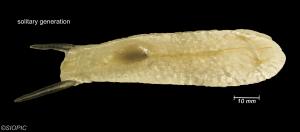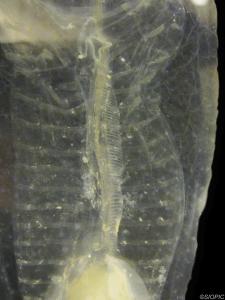Thetys vagina
The aggregate generation zooid possesses a thick, rigid tunic and is covered in small protubrances. The gut causes a swelling of the tunic at the posterior end. The aggregate has five body muscle bands. The solitary generation zooid posesses a very thick, rigid tunic covered in small protubrances and two conspicuous trailing projections that sometimes appear dark green to black. It has twenty or more body muscle bands.
The largest species of salp along the West Coast of the U.S.
Bone, Q. (1998) The biology of pelagic tunicates. Oxford University Press, Oxford.
Wrobel, D. and Mills, C. (1998) Pacific Coast pelagic invertebrates: a guide to the common gelatinous animals. Sea Challengers, Monterey Bay Aquarium, Monterey, CA.
Yount, J.L. (1954) The taxonomy of the Salpidae (Tunicata) of the central Pacific Ocean. Pacific Science 8: 276-330.






